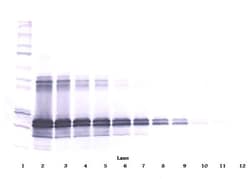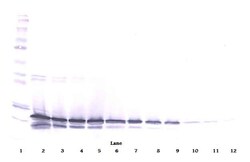Learn More
FGF9 Polyclonal Antibody, Biotin, PeproTech®, Invitrogen™ 
Rabbit Polyclonal Antibody
$337.00 - $432.00
Specifications
| Antigen | FGF9 |
|---|---|
| Concentration | 0.1-1.0 mg/mL |
| Applications | ELISA, Western Blot |
| Classification | Polyclonal |
| Conjugate | Biotin |
| Catalog Number | Mfr. No. | Quantity | Price | Quantity | |||||
|---|---|---|---|---|---|---|---|---|---|
| Catalog Number | Mfr. No. | Quantity | Price | Quantity | |||||
500P66BT25

|
Invitrogen™
500P66BT25UG |
25 μg |
Each for $337.00
|
|
|||||
500P66BT50

|
Invitrogen™
500P66BT50UG |
50 μg |
Each for $432.00
|
|
|||||
|
50-271-8461
|
Invitrogen™
500P66BT500UG |
500 μg |
N/A
|
N/A | |||||
| Please call Customer Service at 1-800-234-7437 or send an email to help@thermofisher.com for assistance. | |||||||||
Description
AA Sequence of recombinant protein: PLGEVGSYFG VQDAVPFGNV PVLPVDSPVL LNDHLGQSEA GGLPRGPAVT DLDHLKGILR RRQLYCRTGF HLEIFPNGTI QGTRKDHSRF GILEFISIAV GLVSIRGVDS GLYLGMNEKG ELYGSEKLTQ ECVFREQFEE NWYNTYSSNL YKHVDTGRRY YVALNKDGTP REGTRTKRHQ KFTHFLPRPV DPDKVPELYK DILSQS. Preparation: Produced from sera of rabbits immunized with highly pure Recombinant Murine FGF-9. Anti-Murine FGF-9-specific antibody was purified by affinity chromatography and then biotinylated. Sandwich ELISA: To detect mFGF-9 by sandwich ELISA (using 100 μL/well antibody solution) a concentration of 0.25-1.0 μg/mL of this antibody is required. This biotinylated polyclonal antibody, in conjunction with PeproTech Polyclonal Anti-Murine FGF-9 (500-P66) as a capture antibody, allows the detection of at least 0.2-0.4 ng/well of Recombinant mFGF-9. Western Blot: To detect mFGF-9 by Western Blot analysis this antibody can be used at a concentration of 0.1-0.2 μg/mL. Used in conjunction with compatible secondary reagents the detection limit for Recombinant mFGF-9 is 1.5-3.0 ng/lane, under either reducing or non-reducing conditions. 500-P66BT-1MG will be provided as 2 x 500 μg
The protein encoded by this gene is a member of the fibroblast growth factor (FGF) family. FGF family members possess broad mitogenic and cell survival activities, and are involved in a variety of biological processes, including embryonic development, cell growth, morphogenesis, tissue repair, tumor growth and invasion. This protein was isolated as a secreted factor that exhibits a growth-stimulating effect on cultured glial cells. In nervous system, this protein is produced mainly by neurons and may be important for glial cell development. Expression of the mouse homolog of this gene was found to be dependent on Sonic hedgehog (Shh) signaling. Mice lacking the homolog gene displayed a male-to-female sex reversal phenotype, which suggested a role in testicular embryogenesis.Specifications
| FGF9 | |
| ELISA, Western Blot | |
| Biotin | |
| Rabbit | |
| Mouse | |
| P54130 | |
| 14180 | |
| E.coli-derived Recombinant Murine FGF-9. | |
| Antigen affinity chromatography | |
| FGF9 |
| 0.1-1.0 mg/mL | |
| Polyclonal | |
| Lyophilized | |
| RUO | |
| PBS with no preservative | |
| Eks; elbow knee synostosis; FGF; Fgf9; FGF-9; Fibroblast growth factor; Fibroblast growth factor 9; fibroblast growth factor 9 (glia-activating factor); GAF; glia activating factor; glia-activating factor; HBFG-9; HBGF-9; Heparin-binding growth factor 9; M-FGF-9; SYNS3 | |
| FGF9 | |
| Primary | |
| -20°C |


